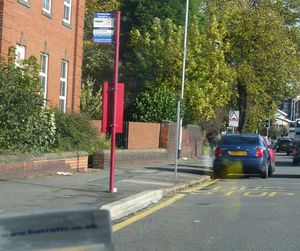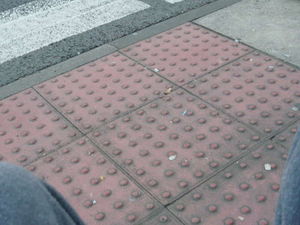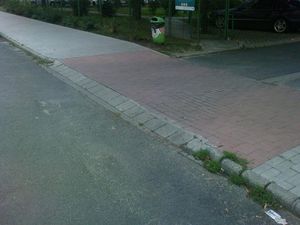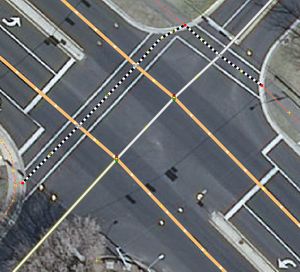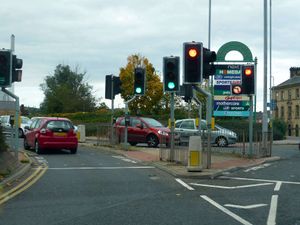Proposal:Kerb
| kerb | |
|---|---|
| Proposal status: | Proposed (under way) |
| Proposed by: | Pobice |
| Tagging: | kerb=raised/lowered/flush/rolled/unknown and kerb:height=<value in cm> (optional) |
| Applies to: | |
| Definition: | Properties of a kerb to aid with accessibility |
| Statistics: |
|
| Draft started: | 2010-12-12 |
| RFC start: | 2011-06-21 |
Proposal
A kerb (American English curb) is the edge where a road meets a sidewalk. As these are transition points between different surfaces and/or elevations, the locations of kerbs are important features to pedestrians, cyclists, and especially to those with reduced mobility (e.g., in wheelchairs).
The proposed key is kerb=*, and is used on the node of a highway=footway, highway=cycleway, or highway=path at the location of the kerb (at the edge of the street). If the kerb is identical on both sides of a crossing, it is possible to add the kerb=* tag to the highway=crossing node, which sacrifices accuracy for simplicity.
Note: As a policy OSM uses British English terms for most tags in preference to North American English. In this case kerb rather than curb.
Tagging
Possible values for the tag are shown in the below table. Keep in mind that the heights given are only indicative, choice of a particular value should depend only on functional considerations. In other words, it is better to consider wheelchair/bicycle accessibility rather than the specific height of the kerb when choosing a value.
| Value | Typical height | Typical use | Description | Example |
|---|---|---|---|---|
| lowered | ~3cm | Crossings & driveways | Lowered kerbs are often found at crossing and driveways. They help ensure the crossing can be used by wheelchair users and allow access to drives. Some names for objects that fall into this category include driveway apron, curb cut (U.S.), curb ramp, dropped kerb (UK), pram ramp, and kerb ramp (Australia). Implies wheelchair=yes. | |
| raised | >3cm | Bus stops & older kerbs | Raised sufficiently to prevent traversal by wheelchairs, as well as an impediment to bicycles. Typically seen at bus stops to provide a level platform to enter bus. Kassel kerbs are a special type of raised kerbs that are designed to guide the tires of a stopping bus. At least in the US, this is also the most common kerb at footway crossings before recent accessibility regulations came into existence. (Note: may be considered normal or yes pending discussion.) Aside from the general method, this can also be added to the highway=bus_stop node or platform node/way. Implies wheelchair=no, and may be used to increase the cost of traveling over this kerb by bicycle. | |
| flush | ~0cm | Crossings & driveways | Similar to lowered, but kerb isn't of sufficient height to be noticed by blind users. May be combined with tactile paving to solve this issue. Implies wheelchair=yes. | |
| rolled | N/A | Residential streets | Rolled is used to designate a curb traversable by vehicles and bicycles, but not wheelchairs. These are sometimes found in planned residential areas, providing access to driveways and sidewalks. This is not to be confused with kerb=lowered, which has a more gentle incline suitable for wheelchair use. Implies wheelchair=no. | |
| ?? | N/A | Driveways | A typical curb for driveways traversable by vehicles and bicycles, but not wheelchairs, due to too high degrees. Implies wheelchair=no. | |
| yes | Any | Some sort of kerb is present, but it can't or hasn't yet been determined whether it is raised, lowered, flush, etc. This may be useful when mapping via aerial imagery (prior to field survey) or if the exact type of kerb can't be recalled. Cautious routers could consider this to mean wheelchair=no, so whenever possible this value should not be used other than on a temporary basis. | ||
| no | N/A | No kerb is present. This may be useful to make it clear there is no kerb present if there used to be a kerb at this location. |
kerb:height=<height><unit>
If exact height of the kerb is know this can also be marked using the tag kerb:height=*. Please state the unit used in the tag.
Examples
| Type | Tagging |
|---|---|
| Red nodes are tagged with kerb=lowered, crossing ways are marked with highway=footway and footway=crossing, crossing nodes are taggged with highway=crossing and crossing=traffic_signals. | |
| Add to either the bus stop or the platform kerb=raised. It is assumed the kerb tag refers to the edge between the road and the platform. If you wish to explicitly map, tag the actually kerb as the way on the platform area. | |
| Use kerb=lowered on the nodes of the footway at the locations of the kerbs. Assuming both sides of the crossing are the same this could be added to the crossing node. | |
| Use kerb=flush and tactile_paving=yes on the nodes of the footway at the locations of the kerbs. Assuming both sides of the crossing are the same this could be added to the crossing node. | |
| This shows a raised kerb at the tram stop, a lowered next to it at the crossing, and a regular one closest to the viewer. |
Applies to
The proposed tagging applies to ![]() nodes and
nodes and ![]() ways. When tagging ways please ensure you also apply the tag to any node where two ways intersect to help data consumers.
ways. When tagging ways please ensure you also apply the tag to any node where two ways intersect to help data consumers.
Rendering
A renderer may choose to use a symbol on these nodes to indicate the type of kerb, or perhaps wheelchair accessibility.
Related tags
The kerb=* node can also be tagged with tactile_paving=* to assist vision impaired individuals, and is especially important on kerb=flush nodes.
Features/Pages affected
- Proposed features/sloped curb - amenity=sloped_curb and sloped_curb=* would be deprecated by kerb=*, except in certain cases (to be discussed)
RFC
An RFC was sent to the tagging list on 2011/06/21, Feature Proposal - RFC - Kerb.
- 2011/06/22 - Per mailing list discussion, changed unknown to yes, and added back no value. Also made heights indicative and emphasized functional definition.
Open issues
- kerb:height - default unit
- kerb tags on ways
- Add a normal tag and use raised for bus platform type kerbs*
- Remove height guidance and base on local norms*
*From tagging mailing list
See also
- steps features
- barrier
- wheelchair
- tactile_paving
- Proposed features/Traffic island
- Proposed features/sloped curb
- Proposed features/right left
- Relations/Proposed/Area
External links
- Wikipedia articles on kerb, and curb cut
- FHWA: Designing Sidewalks and Trails for Access, Chapter 7. Curb Ramps - From the US Federal Highways Administration, more than you could ever want to know about curb ramps. Other chapters from this guide might also be useful.
